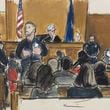ART REVIEW
“The Unbearable Flatness of Being”
Through Feb. 6, 2016. 10 a.m.-5 p.m. Tuesdays-Saturdays. $8 general admission, $5 for students with ID and seniors 65+; free, children ages 6 and under, members and U.S. military with ID. Museum of Contemporary Art of Georgia, 75 Bennett St., Suite A2, Atlanta. 404-367-8700, www.mocaga.org.
Bottom line: An artist known for collisions of cuteness and violence takes her work to the next level in a show about the horror dwelling beneath the surface of things.
The Museum of Contemporary Art of Georgia's Working Artist Project grant allows artists the chance to take their work to the next level: The award is a chance to work bigger and longer on a sustained idea.
The three annual winners of the award are given a stipend, a studio assistant, and a featured exhibition at MOCA GA. And Sarah Emerson — a 2014/2015 winner along with Jonathan Bouknight and Sheila Pree Bright — has definitely gone big in her dark, blood-filled, violence-laced, bubbling and brewing psychological stew "The Unbearable Flatness of Being," a phantasmagorical fugue on repressed violence and hidden terrors, at MOCA GA.
Consisting of four large panels stitched together from smaller canvases, Emerson’s mind-altering solo show is a CinemaScope exorcism of some of society’s darkest demons, a “Guernica” painted in the blazing colors and gooey forms of a Disney cartoon.
Emerson, who lives in Atlanta but attended graduate school at London’s prestigious Goldsmiths College, has always worked a potent, personal brew of sweetness colliding with some very nasty, dark business in her colorfully cartoonish paintings. With their bold, fruity colors and kinetic, loopy figures and lines, her style can often evoke paint by numbers or the repeating scroll behind a TV cartoon’s main action.
Emerson’s epic acrylic paintings are essentially landscapes, though abstracted ones of disturbing surreality. There are rainbows and peppy bursts of crimson and pink, swirling lakes, undulating hills and flower beds, as if Emerson is capturing a lovely forest glade alive with flowing water and gentle breezes blowing clouds across the horizon.
But look closer and be afraid. Very afraid. Beneath those sugar-dusted surfaces and birthday party colors, something wicked this way comes.
In the enormous frieze “As Above So Below,” something even ickier than usual is afoot. The adorable Disney-esque rabbits and deer that have often populated Emerson’s paintings in the past are gone. Instead, the only living presence can be seen in the blinking eyes peeping out from the shadows, as if too terrified to come into the light. Those frightened creatures wear gestures of exaggerated bug-eyed comic fright, but seem far from funny in Emerson’s hands.
In “Of Brute Matter,” the blinking eyes, hiding in the secret sanctuaries of rotten trees and caves, seek shelter from what looks like a war-ravaged landscape. In “Here’s Looking at You Too,” the World War II graffiti figure “Kilroy” appears, an apt analogy to Emerson’s tactic of pairing whimsy with devastation, much like that cartoon icon popping up in the midst of war.
The entire world depicted in Emerson’s paintings is dripping, melting and changing, as if covered in a layer of cake and ice cream melting to reveal something previously hidden. Emerson’s transformation of her landscapes into morphing, melting places in constant motion contributes to the disorienting perspective and a feeling that the world has been rendered asunder by grave doings.
As the ground shifts and the clouds part, you can see skulls emerging from the soil, bodies that won’t stay buried. The gurgling, gray clusters of bubbles dotting the landscape suddenly suggest percolating toxins. The thick rivers look choked with sludge, and those skulls hint at genocides long hidden from view. Trees grow in strange humanoid shapes, their trunks straddling the earth, as if reaching for steady hold in this shape-shifting world. And those bursts of red suddenly take on a different cast: They look like spurts of blood emerging from fresh wounds or the hot orange explosion from a gun barrel.
It’s a natural world contaminated by the implication of dark, nefarious forces operating beyond our view. And like dark events in the real world, we can choose to look deeper, to penetrate the world of surfaces, or simply pretend, and dwell on the surface of those bright colors and funny blinking eyes.





